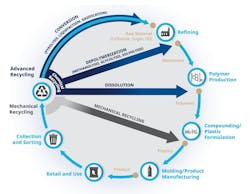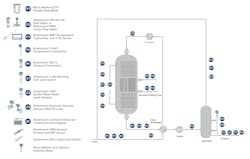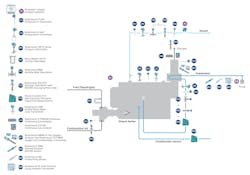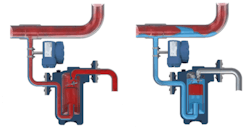The first article of this three-part series ran in our sister publication Plastics Machinery & Manufacturing and was titled Converting Plastics Using Pyrolysis, and it laid out the global need for higher levels of plastic recycling to alleviate growing trash problems. It then looked at pyrolysis processes as a method of breaking down plastic waste into useful chemical components. It is one of several possible approaches for turning plastic back into a precursor suitable for reuse, generally to make new plastic, but not always.
Different processes break down polymers in various ways since each plastic has its own characteristics. Most recycling efforts focus on three of the six polymers used most frequently for packaging and similar applications. The most common, as indicated by their recycling number designations, are 1-PET (polyethylene terephthalate, sometimes abbreviated PETE), 2-HDPE (high-density polyethylene) and 5-PP (polypropylene). Others, such as 3-PVC (polyvinyl chloride), 4-LDPE (low-density polyethylene) and 6-PS (polystyrene), are less common and more difficult to recycle.
Pyrolysis (Figure 1) is the most comprehensive approach because it turns complex polymer molecules into syngas, or to the basic hydrocarbon molecules closer to the fractions from crude oil distillation. Either can be reused as feedstocks for manufacturing new plastic, or for other fuel or chemical purposes. Pyrolysis has a major advantage over other approaches in that it works with mixed and minimally sorted plastics, avoiding a costly step.
But it is possible to create virgin quality plastic via recycling without the complete chemical breakdown of pyrolysis using depolymerization, the process of turning plastic waste back into its monomer molecule so it can be purified and then repolymerized back into plastic. While this is theoretically possible for most polymers, to date, commercialized processes have concentrated on PET because of its suitability and great abundance. Depolymerization processes developed for PET use methanolysis to break it down into its basic monomer. The plastic waste must be carefully sorted as other types do not respond to the same conditions.
Most common forms of PET are bottles and films, but even polyester fabrics are a form of PET. Once in its liquid monomer phase, the purification process extracts dyes and pigments, so colored feedstock is not a problem. If small amounts of other plastics get into the reactor, they can usually be strained out after liquification. Once contaminants have been removed, the monomer is repolymerized, creating virgin-quality pellets.
The heart of the methanolysis process is a catalytic reactor (Figure 2), where shredded PET waste is heated in methanol, either as a liquid or superheated vapor, at high temperatures and pressure in the presence of a transesterification catalyst. The result is dimethyl terephthalate (DMT) and ethylene glycol. An additional distillation step separates the components. Recovered DMT, once purified, can be repolymerized into new PET, and ethylene glycol has many possible uses.
Supporting a catalytic reactor
Effective depolymerization depends on the catalytic reactor working optimally, delivering complete breakdown of the solid PET feedstock, while using methanol and other resources efficiently. PET and methanol are mixed, preheated and forced into the reactor under pressure. Once inside the reactor, it is critical to keep the mixture agitated to maximize catalyst exposure. Internal heating coils fed by steam maintain optimum temperature.
As with distillation, controlling a catalytic reactor requires instrumentation covering critical process variables:
- Flowmeters ensure feedstock flow into the reactor is correct since it determines residence time, ensuring a complete reaction. Since there is heavy solids content in the feedstock, the flowmeter must not create a clogging hazard.
- Level instruments monitor fluid handling systems supporting the reactor — including methanol, ethylene glycol and others — to prevent interrupting continuous production.
- Pressure transmitters monitor the reactor itself since this is critical to complete conversion. Additionally, they monitor ancillary systems, including steam flow to the reactor, plus heat exchangers.
- Temperature sensors are installed at many points, particularly at multiple levels in the reactor and distillation column, to ensure the desired temperature profile is maintained to support a complete reaction with the shortest residence time.
- Viscosity and density readings at the reactor exit indicate if unreacted PET is still present, which may be caused by feedstock impurities or other upset conditions, important because unreacted PET degrades catalyst performance.
Equipment reliability and safety
The depolymerization process is considered severe and hazardous service since methanol at high temperature and pressure represents a serious safety threat. The process automation system must keep the reaction under control to avoid upsets that interfere with production and could cause safety incidents.
If up-to-date equipment is used, instrumentation supporting the process can provide diagnostic data, making it possible to avoid field device failures, and even process upsets.
- Device diagnostic capabilities analyze the health of the instrument itself and can warn the reliability team of an internal component behaving erratically or nearing failure.
- Diagnostic information can be sent via HART or WirelessHART and via Bluetooth technology on an increasing number of devices (Figure 3).
- Internal flowmeter verification capabilities provide deep device diagnostic information from Coriolis, magnetic and ultrasonic flowmeters. These types of devices monitor key performance indicators continuously, maintaining measurement accuracy.
- Instruments provide insight into the process itself since an operating unit exhibits specific characteristics that can be detected and characterized by the transmitters. For example, a differential pressure (DP) transmitter can detect conditions such as an impulse line clogging, pump cavitation or distillation column flooding.
- Installation and maintenance diagnostics ensure the connection between device and host system is correct. They detect pitfalls in current loops that can result in on-scale failures caused by degraded wiring, water in a transmitter housing or other conditions.
When these diagnostics operate in an integrated environment, such as the Plantweb Insight digital ecosystem (Figure 4), it transforms data from field instruments sensors and smart valves into actionable information for improved decision-making.
Similarly, safety instrumented systems (SISs) must protect the process in the event of an upset the main control system can’t correct.
Energy and emissions management
The depolymerization process is energy-intensive since it involves a high-temperature reaction followed by distillation. Consequently, it depends on boilers to generate steam, likely combined with a fired heater and heat exchangers to raise the temperature of feedstocks ahead of the reactor. These processes are combined with a reboiler and reflux temperature control for the distillation column.
Steam production and distribution systems (Figure 5) are part of the plastic recycling chemical processes discussed here, primarily to deliver heat to processes via heat exchangers. However, steam systems are expensive, can be inefficient and have high maintenance requirements. Here are two simple solutions that can result in major steam system cost savings.
Steam consumption monitoring
Many steam distribution systems are wasteful because there is little or no indication of how much steam is going to each application. Determining where problems exist requires accurate flow measurement to each area, and even to individual applications, using large amounts of steam.
When steam distribution is measured in detail, it is possible to identify steam hogs and leaks, reducing overall consumption and saving fuel costs.
Steam trap monitoring
When steam is used with a heat exchanger, it generally condenses back into water that must be removed from the steam line. Such situations call for a steam trap to separate and remove condensate without releasing live steam. How well steam traps perform affects the efficiency and sustainability of an entire steam distribution system. Steam trap service is harsh, so eventually their mechanisms often fail (Figure 7), so they must be checked frequently to ensure correct operation.
Since manual checking is not always practical, an acoustic sensor can be mounted permanently on the piping adjacent to a steam trap (Figure 8) to sense its operation continuously. Such sensors are internally powered with a battery and use WirelessHART networks, and they can send data to maintenance and reliability departments so repairs can be made to minimize wasted steam from traps stuck open. These devices can be mounted with hose clamps so there is no need for a process penetration or shutdown.
Partnership for plastics recycling
Partnering with a supplier able to provide a complete portfolio of automation solutions, together with extensive domain expertise, can help reduce project complexity and drive operational efficiency, while maximizing plant safety and reliability.
Emerson is uniquely positioned to deliver environmentally sustainable solutions for customers across the full plastic production and recycling value chain. Advanced automation technologies are helping to improve productivity, reduce variability, decrease energy use, lower emissions and validate operational sustainability for established companies and startups as they answer this compelling environmental challenge.









